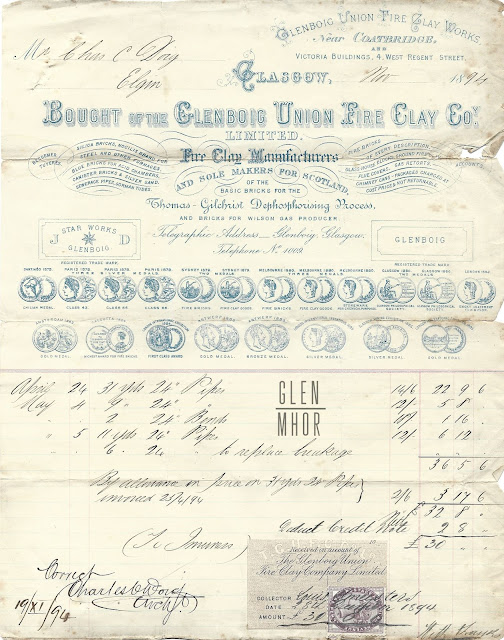November 1894 Glenboig Fire Clay Works Glen Mhor Invoice
Continuing our 1894 theme with the recently acquired Glen Mhor document collection, we come across perhaps the most aesthetically pleasing of paper invoices. This elaborate receipt from the Glenboig Fire Clay Works, dated November 1894, is both striking and comprehensive.
Addressed to Charles C. Doig of Elgin, Glenboig were firmly established as a leading manufacturer of fire-clay bricks in Scotland and further afield. Grace's Guide provides an overview of the company, which persisted in some capacity until the 1970s, while Glasgow West Address provides further detail and there's a wonderfully detailed and rich retelling of its history on Scottish Brick History - I'm glad others love bricks.
It would seem apt that a new distillery, seeking to create the best whisky, would involve experts in their own field to ensure a reliable and safe environment. Given the importance of fire at Glen Mhor in various stages of production, these bricks would have be required to withstand the degree of heat involved, such as beneath the stills in this image from the 1890s:
The small town of Glenboig gained renown as the foremost producer of bricks in the world and a visit to Scottish Brick History shows that its bricks are still being found across the world today in a variety of settings. Helping to drive the industrial revolution across Scotland and beyond. Their achievement can be attributed to their access to an outstanding deposit of fireclay in close proximity to the coal mines in the area. At the time of this order in 1894, the company would have been producing more than 100,000 bricks daily.
This image kindly provided Culture North Lanarkshire Museums shows the main site in the early 1900s:
If Glenboig was Charles C. Doig's preferred option, then it is highly probable that these bricks were used in numerous distilleries throughout Scotland. I'm sure I'm not alone in acquiring the odd brick remnant from a decaying distillery site, having a Bunnahhabhain brick in my garage as a memento, thanks Rose. Next time you see a distillery, or related building, being pulled down in some shape or form (a disappointing habit of the Scotch industry), maybe flip one of the disregarded bricks over, to see if it is adorned with a Glenboig mark as seen in this image provided by North Lanarkshire once again, showing a Glenboig brick from the early 1900s
Yet Glenboig weren't just in the business of making bricks, they made a variety of items including blast furnace blocks, chimney fittings and pipes amongst other things. This invoice indicates an order for pipes intended for Glen Mhor.
In November 1894, the distillery began operations earlier than its official start date of 8th December 1894. The purpose of these initial test runs was to identify issues and flaws within the distillery, as exemplified by the new Macallan extension, that may have been overlooked in the design, process, or materials used.
That seems to be the case here as any bricks at the distillery would have been long cemented into position. Instead, this pipe invoice gives us an order for various materials, but also highlights one at 6 yards, 24 inches, as a replacement for a leakage on site - suggesting that some form of distillation, albeit in practice runs, was taking place on site. This Glenboig advert from 1893, my thanks to Scottish Brick History, highlights the range of items produced:
Wonderfully, the invoice is marked as 'correct' on 19th November 1894 by Charles C. Doig, the architect, in the bottom left corner.
For such a distinguished invoice, I was expecting a more elaborate description (as seen in the upcoming Johnnie Walker receipt), but it is entirely simple. With only "61" and the name of the company recorded, it is likely some form of filing system from its residence in Glen Mhor.
Hopefully, I can bring you more brick related finds relating to Glen Mhor, and if anyone was fortunate enough to grab a couple of bricks during demolition in the 1980s, please get in touch.





Comments
Post a Comment